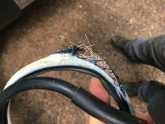Yes that's right, in my 1P8S setup there are 7 bus bars so there would be a total of 17.5W of heat sinking into my 100 lb pack, about 1 cubic foot, if I was actually running 445A continuous. 17.5W in that volume is not that much. Unless of course you put it in a hermetically sealed highly insulated box, and why would you do that?
Lots of people insulate their batteries for cold. My battery bay in my RV is fully insulated, for example, to the point where I have forced-air cooling routed down to it. It's well within the bounds of reasonableness for that to be the case for someone's DIY pack. (Btw, I heat that bay with a 40W reptile heat pad in the dead of winter at 0F -- a condition very few marine pleasure vessels ever experience or design for, btw.)
No sane person lives on the salt flats for years. Thermal vents and caves are silly examples and not relevant. Marine applications are continuous for many years, with humidity and corrosion, pounding seas, close proximity to living quarters, and if there is a fire you have few options to escape.
The thermal vents were tongue-in-cheek, but lithium battery systems are most definitely engineered for caving, and it only takes 24 hours on the wrong salt flat in the wind with the wrong design and you can wreck some very expensive electronics (and motors for that matter). They are incredibly aggressive environments, particularly for electrical systems, and I would argue much more challenging to design for than an average day on the typical milk run route.
Yes, I've heard some similar things. But we're talking about basic things here like ohm's law and heating. Here's a good experiment, take a 17W heater and attach it to a 100 lb 1 cubic foot disconnected battery bank and let it come to equilibrium. It will not be very hot.
I guess you are assuming the battery bank perfectly dissipates the heat with no gradient or local heating effects? Surely that's not the case in real life.
I'm standing here, next to the same battery bank I mentioned up thread, running the same 130A through the same busbar I mentioned before. The bar is sitting at 93F right now. The air is 70F, and the plastic surrounding the aluminum cell shells is at 73F (well, actually, 72F on the outside cells and 74F on the inside ones!).
The gradient between the bus bar and the plastic wrapper must include all temperatures between 93 and 73, right, by the second fundamental theorem of calculus? So how is it that we can be sure that the top inch of "jelly roll" under the hot bus bar is not at 92F, or 90F, or something
substantially greater than 73F?
Now, double the current. The new ohmic heating is something capable of pushing the bar closer to
160F. (Yes, that comes close to matching the data in the vaunted ABYC table.) The problem is, what is the temperature of the battery anode, cathode, and electrolyte inside the case, right below the terminal?
It defies reason that it will be at an acceptable level for long-term health of at least part of that cell.
I feel like I'm somehow not making the concern clear, so I don't know if this example muddies the water or clarifies what I'm getting at. But this is not just about safety, it's about best practice for managing lithium chemistries.
But anyway 400A at 12v is of course 4800W, which is a bit shy of the 6000W 2 minute surge that the Multiplus is capable of. At 24V, 300A is 7200W. So at 24V you can actually use the rated surge capability without risking blowing that big fuse.
Ah, got it. Yeah, the theoretical surge capability of the coil is impressive, indeed, and it's interesting that they basically end up derating their own unit in the 12V model. I bet it's because of that fuse practicality, too.
Anyway, that is only "recommended" fusing, not required, so presumably you could go bigger with sufficient wiring (or sufficiently-short peak draws). Performance envelopes are complex and multivariate, though; a simple "we can do this many KVA for n seconds" grossly oversimplifies it. My experience with Victron inverters is that they perform well below what their marketing sheets state in some cases. (I wouldn't be surprised if you could get 6KVA for far less time if you don't have the unit installed in a freezer, for example.)
No and no. I'm guessing it's because the insulation surface has higher emissivity than bare copper, and vertical bus bars set up a chimney-like convection that cools them better. Did I pass?
You got 50%, enough for a... silver star?
The vertical bars indeed do facilitate faster convective action.
The insulated wire performs a bit better because the exposed surface area is larger.







